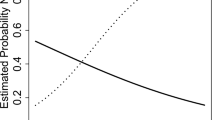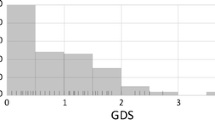Abstract
YWHAE (14-3-3ε) protein levels are considered to be a reliable biomarker for neurodegeneration. The YWHAE protein interacts both directly and indirectly with human immunodeficiency virus (HIV) accessory proteins, leading to cell death. The purpose of this study was to examine the relationship between YWHAE polymorphisms and HIV-associated neurocognitive disorder (HAND) and the relationship between YWHAE protein levels and HAND. A cross-sectional study using random samples of HIV-seropositive (n = 20) and HIV-seronegative (controls) (n = 16) women from the Hispanic-Latino Longitudinal Cohort of Women was conducted. Individuals who are HIV-seropositive and heterozygous at the rs4790084/rs1204828 loci in the YWHAE gene were 3× more likely to display reduced cognitive functioning, to have received a HAND diagnosis, and to have less YHWAE protein expressed than homozygotes. Western blots from cerebral spinal fluid indicate that the HIV-seropositive women with HAND expressed 4.5× less YWHAE compared to HIV-seropositive cognitively normal women (94 % sensitivity, 84 % specificity; HIV-seropositive vs. controls). Therefore, polymorphism in YWHAE may be a genetic risk factor for HAND and levels of YWHAE protein are a likely biomarker for neurocognitive status in HIV-seropositive women.


Similar content being viewed by others
References
Aitken A, Jones D, Soneji Y, Howell S (1995) 14-3-3 proteins: biological function and domain structure. Biochem Soc Trans 23:605–611
American Academy of Neurology AIDS Task Force (1991) Nomenclature and research case definitions for neurologic manifestations of human immunodeficiency virus-type 1 (HIV-1) infection. Report of a Working Group of the American Academy of Neurology AIDS Task Force. Neurology 41:778–785
American Academy of Neurology AIDS Task Force (1996) Clinical confirmation of the American Academy of Neurology algorithm for HIV-1-associated cognitive/motor disorder. The Dana Consortium on Therapy for HIV Dementia and Related Cognitive Disorders. Neurology 47:1247–1253
Berg D, Holzmann C, Riess O (2003) 14-3-3 proteins in the nervous system. Nat Rev Neurosci 4:752–762
Boesenberg-Grosse C, Schulz-Schaeffer WJ, Bodemer M, Ciesielczyk B, Meissner B, Krasnianski A, Bartl M, Heinemann U, Varges D, Eigenbrod S, Kretzschmar HA, Green A, Zerr I (2006) Brain-derived proteins in the CSF: do they correlate with brain pathology in CJD? BMC Neurol 6:35
Bolton DL, Barnitz RA, Sakai K, Lenardo MJ (2008) 14-3-3 theta binding to cell cycle regulatory factors is enhanced by HIV-1 Vpr. Biol Direct 3:17
Che XH, Chen H, Xu ZM, Shang C, Sun KL, Fu WN (2010) 14-3-3epsilon contributes to tumour suppression in laryngeal carcinoma by affecting apoptosis and invasion. BMC Cancer 10:306
Cohen J (1988) Statistical power analysis for the behavioral sciences, 2nd edn. Lawrence Erlbaum, Hillsdale, NJ
Cohen EA, Terwilliger EF, Jalinoos Y, Proulx J, Sodroski JG, Haseltine WA (1990) Identification of HIV-1 vpr product and function. J Acquir Immune Defic Syndr 3:11–18
Collins SJ, Sanchez-Juan P, Masters CL, Klug GM, van Duijn C, Poleggi A, Pocchiari M, Almonti S, Cuadrado-Corrales N, de Pedro-Cuesta J, Budka H, Gelpi E, Glatzel M, Tolnay M, Hewer E, Zerr I, Heinemann U, Kretszchmar HA, Jansen GH, Olsen E, Mitrova E, Alperovitch A, Brandel JP, Mackenzie J, Murray K, Will RG (2006) Determinants of diagnostic investigation sensitivities across the clinical spectrum of sporadic Creutzfeldt–Jakob disease. Brain 129:2278–2287
Gardino AK, Yaffe MB (2011) 14-3-3 proteins as signaling integration points for cell cycle control and apoptosis. Semin Cell Dev Biol 22:688–695
Gelman BB, Nguyen TP (2010) Synaptic proteins linked to HIV-1 infection and immunoproteasome induction: proteomic analysis of human synaptosomes. J Neuroimmune Pharmacol 5:92–102
Geschwind MD, Martindale J, Miller D, DeArmond SJ, Uyehara-Lock J, Gaskin D, Kramer JH, Barbaro NM, Miller BL (2003) Challenging the clinical utility of the 14-3-3 protein for the diagnosis of sporadic Creutzfeldt–Jakob disease. Arch Neurol 60:813–816
He J, Choe S, Walker R, Di Marzio P, Morgan DO, Landau NR (1995) Human immunodeficiency virus type 1 viral protein R (Vpr) arrests cells in the G2 phase of the cell cycle by inhibiting p34cdc2 activity. J Virol 69:6705–6711
Heaton RK, Clifford DB, Franklin DR Jr, Woods SP, Ake C, Vaida F, Ellis RJ, Letendre SL, Marcotte TD, Atkinson JH, Rivera-Mindt M, Vigil OR, Taylor MJ, Collier AC, Marra CM, Gelman BB, McArthur JC, Morgello S, Simpson DM, McCutchan JA, Abramson I, Gamst A, Fennema-Notestine C, Jernigan TL, Wong J, Grant I (2010) HIV-associated neurocognitive disorders persist in the era of potent antiretroviral therapy: CHARTER study. Neurology 75:2087–2096
Hsich G, Kenney K, Gibbs CJ, Lee KH, Harrington MG (1996) The 14-3-3 brain protein in cerebrospinal fluid as a marker for transmissible spongiform encephalopathies. N Engl J Med 335:924–930
Ikeda M, Hikita T, Taya S, Uraguchi-Asaki J, Toyo-oka K, Wynshaw-Boris A, Ujike H, Inada T, Takao K, Miyakawa T, Ozaki N, Kaibuchi K, Iwata N (2008) Identification of YWHAE, a gene encoding 14-3-3epsilon, as a possible susceptibility gene for schizophrenia. Hum Mol Genet 17:3212–3222
Iskander S, Walsh KA, Hammond RR (2004) Human CNS cultures exposed to HIV-1 gp120 reproduce dendritic injuries of HIV-1-associated dementia. J Neuroinflammation 1:7
Kapasi AA, Fan S, Singhal PC (2001) Role of 14-3-3epsilon, c-Myc/Max, and Akt phosphorylation in HIV-1 gp 120-induced mesangial cell proliferation. Am J Physiol Renal Physiol 280:F333–F342
Kino T, Pavlakis GN (2004) Partner molecules of accessory protein Vpr of the human immunodeficiency virus type 1. DNA Cell Biol 23:193–205
Kino T, De Martino MU, Charmandari E, Ichijo T, Outas T, Chrousos GP (2005a) HIV-1 accessory protein Vpr inhibits the effect of insulin on the Foxo subfamily of forkhead transcription factors by interfering with their binding to 14-3-3 proteins: potential clinical implications regarding the insulin resistance of HIV-1-infected patients. Diabetes 54:23–31
Kino T, Gragerov A, Valentin A, Tsopanomihalou M, Ilyina-Gragerova G, Erwin-Cohen R, Chrousos GP, Pavlakis GN (2005b) Vpr protein of human immunodeficiency virus type 1 binds to 14-3-3 proteins and facilitates complex formation with Cdc25C: implications for cell cycle arrest. J Virol 79:2780–2787
Kogan M, Rappaport J (2011) HIV-1 accessory protein Vpr: relevance in the pathogenesis of HIV and potential for therapeutic intervention. Retrovirology 8:25
Lipton SA (1992) Requirement for macrophages in neuronal injury induced by HIV envelope protein gp120. Neuroreport 3:913–915
Luo X, Carlson KA, Wojna V, Mayo R, Biskup TM, Stoner J, Anderson J, Gendelman HE, Melendez LM (2003) Macrophage proteomic fingerprinting predicts HIV-1-associated cognitive impairment. Neurology 60:1931–1937
Lyons JL, Uno H, Ancuta P, Kamat A, Moore DJ, Singer EJ, Morgello S, Gabuzda D (2011) Plasma sCD14 is a biomarker associated with impaired neurocognitive test performance in attention and learning domains in HIV infection. J Acquir Immune Defic Syndr 57:371–379
Matsuda N, Tanaka H, Yamazaki S, Suzuki J, Tanaka K, Yamada T, Masuda M (2006) HIV-1 Vpr induces G2 cell cycle arrest in fission yeast associated with Rad24/14-3-3-dependent, Chk1/Cds1-independent Wee1 upregulation. Microbes Infect 8:2736–2744
Mhawech-Fauceglia P, Herrmann FR, Andrews C, South S, Beck A, Lele S, Odunsi K (2009) 14-3-3sigma expression and prognostic value in patients with epithelial ovarian carcinoma: a high throughput tissue microarray analysis. Eur J Surg Oncol 35:763–767
Mignon-Ravix C, Cacciagli P, El-Waly B, Moncla A, Milh M, Girard N, Chabrol B, Philip N, Villard L (2010) Deletion of YWHAE in a patient with periventricular heterotopias and pronounced corpus callosum hypoplasia. J Med Genet 47:132–136
Morales D, Acevedo SF, Skolasky RL, Hechavarria R, Santiago S, De La Torre T, Maldonado E, Wojna V (2012a) Translational spatial task and its relationship to HIV-associated neurocognitive disorders and apolipoprotein E in HIV-seropositive women. J Neurovirol 18:488–502
Morales D, Skoulakis EC, Acevedo SF (2012b) 14-3-3s are potential biomarkers for HIV-related neurodegeneration. J Neurovirol 18:341–353
Rackstraw S (2011) HIV-related neurocognitive impairment—a review. Psychol Health Med 16:548–563
Shiga Y, Wakabayashi H, Miyazawa K, Kido H, Itoyama Y (2006) 14-3-3 protein levels and isoform patterns in the cerebrospinal fluid of Creutzfeldt–Jakob disease patients in the progressive and terminal stages. J Clin Neurosci 13:661–665
Torres M, Cartier L, Matamala JM, Hernandez N, Woehlbier U, Hetz C (2012) Altered Prion protein expression pattern in CSF as a biomarker for Creutzfeldt–Jakob disease. PLoS One 7:e36159
Ushijima H, Nishio O, Klocking R, Perovic S, Muller WE (1995) Exposure to gp120 of HIV-1 induces an increased release of arachidonic acid in rat primary neuronal cell culture followed by NMDA receptor-mediated neurotoxicity. Eur J Neurosci 7:1353–1359
Vodicka MA, Koepp DM, Silver PA, Emerman M (1998) HIV-1 Vpr interacts with the nuclear transport pathway to promote macrophage infection. Genes Dev 12:175–185
Wakabayashi H, Yano M, Tachikawa N, Oka S, Maeda M, Kido H (2001) Increased concentrations of 14-3-3 epsilon, gamma and zeta isoforms in cerebrospinal fluid of AIDS patients with neuronal destruction. Clin Chim Acta 312:97–105
Wojna V, Skolasky RL, Hechavarria R, Mayo R, Selnes O, McArthur JC, Melendez LM, Maldonado E, Zorrilla CD, Garcia H, Kraiselburd E, Nath A (2006) Prevalence of human immunodeficiency virus-associated cognitive impairment in a group of Hispanic women at risk for neurological impairment. J Neurovirol 12:356–364
Wojna V, Robles L, Skolasky RL, Mayo R, Selnes O, de la Torre T, Maldonado E, Nath A, Melendez LM, Lasalde-Dominicci J (2007) Associations of cigarette smoking with viral immune and cognitive function in human immunodeficiency virus-seropositive women. J Neurovirol 13:561–568
Xiao T, Ying W, Li L, Hu Z, Ma Y, Jiao L, Ma J, Cai Y, Lin D, Guo S, Han N, Di X, Li M, Zhang D, Su K, Yuan J, Zheng H, Gao M, He J, Shi S, Li W, Xu N, Zhang H, Liu Y, Zhang K, Gao Y, Qian X, Cheng S (2005) An approach to studying lung cancer-related proteins in human blood. Mol Cell Proteomics 4:1480–1486
Zhao LJ, Mukherjee S, Narayan O (1994a) Biochemical mechanism of HIV-I Vpr function. Specific interaction with a cellular protein. J Biol Chem 269:15577–15582
Zhao LJ, Wang L, Mukherjee S, Narayan O (1994b) Biochemical mechanism of HIV-1 Vpr function. Oligomerization mediated by the N-terminal domain. J Biol Chem 269:32131–32137
Acknowledgments
The study was funded by National Center for Research Resources (NCRR) grant 1U54RR026139-01A1 and the National Institute on Minority Health and Health Disparities 8U54MD007587 to the University of Puerto Rico Medical Science Campus, and National Institute of Mental Health (NIMH) Center for Novel Therapeutics of HIV-associated Cognitive Disorders Pilot Project Grant G12 RR003050 to the John Hopkins University. The study was supported partially by National Institute of Neurological Disorders and Stroke (NINDS) grants S11NS46278 and U54NS43011 (SNRP). The content of this publication is solely the responsibility of the authors and does not necessarily represent the official views of NCRR, NIMHD, NIMH, or NINDS. Thanks to Dr. Carlos Pardo at John Hopkins University for the control CSF samples. Thanks to Dr. Jacob Raber at Oregon Health & Science University for permission to use the Memory Island and for serving as an excellent mentor. Also we appreciate the contribution from Dr. Raul Mayo who conducted neuropsychological testing of cohort participants and Dr. Avindra Nath for his contribution in the development of the cohort and for his continuous collaboration with the SNRP. We acknowledge the support of Tirtsa Porrata-Doria and the Molecular Biology Core Lab (Grant RR003050). Special thanks go to Robert Ritchie of the RCMI Publications Office (G12 RR003050). I would like to thank Madeline Collazo for her help with genotyping.
Conflict of interest
The authors report no conflicts of interest. The authors alone are responsible for the content and writing of the paper.
Author information
Authors and Affiliations
Corresponding author
Rights and permissions
About this article
Cite this article
Morales, D., Hechavarria, R., Wojna, V. et al. YWHAE/14-3-3ε: a potential novel genetic risk factor and CSF biomarker for HIV neurocognitive impairment. J. Neurovirol. 19, 471–478 (2013). https://doi.org/10.1007/s13365-013-0200-z
Received:
Revised:
Accepted:
Published:
Issue Date:
DOI: https://doi.org/10.1007/s13365-013-0200-z




